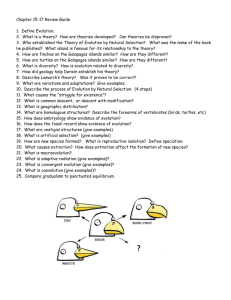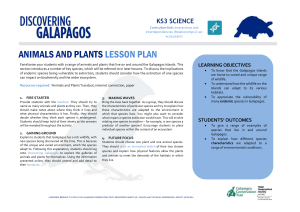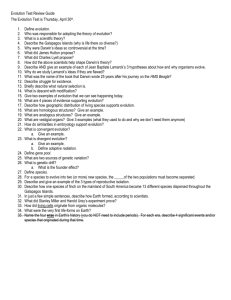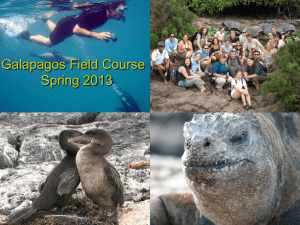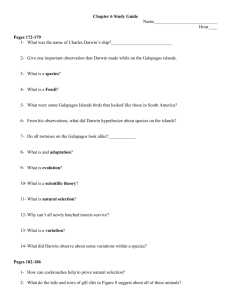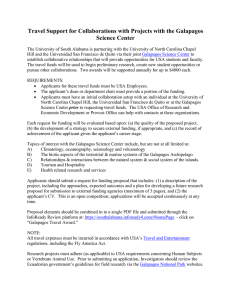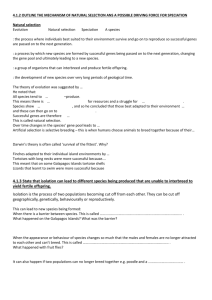El Niño and Its Effects on the Galapagos Islands Letisha McLaughlin
advertisement
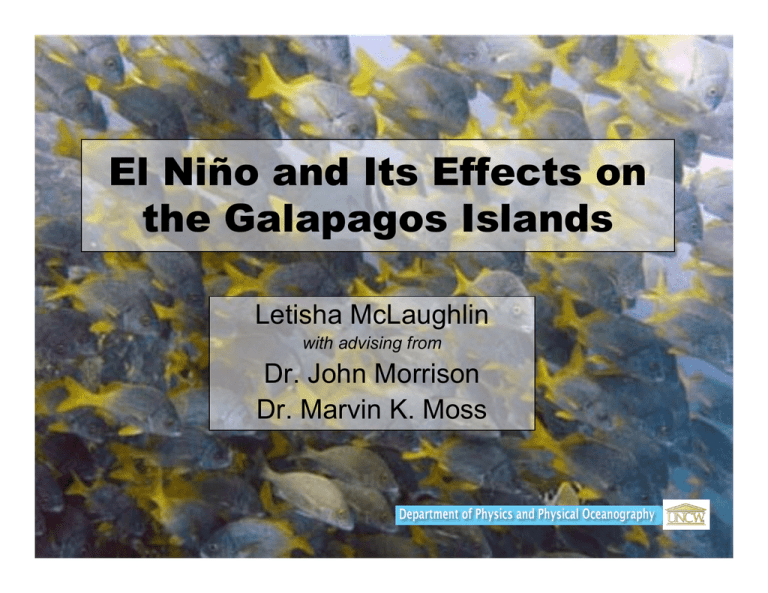
El Niño and Its Effects on the Galapagos Islands Letisha McLaughlin with advising from Dr. John Morrison Dr. Marvin K. Moss Contents • The Galapagos Islands • Some physical oceanography principles • Oceanography of the Islands • El Niño-Southern Oscillation • Oceanographic effects of El Niño on the Galapagos • Biological effects of El Niño Blue-footed Booby The Galapagos Islands • Between 89°W and 92°W along the equator • ~1000 km west of Ecuador • 13 main islands • Known for its unique marine and terrestrial wildlife Biological Diversity • Much of the flora and fauna is endemic to the islands • Geography and oceanography allows for the study of evolution, as Darwin did when he wrote On the Origin of Species… • Some interesting animals include the Galapagos Tortoise, the Marine iguana, and the Galapagos Penguins Brown Pelican How can penguins survive on the equator? Because of the Currents surrounding the Islands! Important Concepts • The ocean and atmosphere are directly coupled • The ocean and atmosphere are considered fluids; they obey all the laws of physics • Major forces which affect the ocean are gravity, frictional forces arising from wind-stress, and buoyancy • Thermocline- depth at which the temperature of the ocean declines rapidly- has the most nutrients • ITCZ (Intertropical Convergence Zone)- The region where northeasterly and southeasterly tradewinds converge creating an area of low pressure along the equator Frigatebird Important Concepts: The Coriolis Force •A fictitious force resulting from the Earth’s rotation •Gravity loosely couples the ocean to the Earth •Air and water masses are deflected to the right in the northern hemisphere and to the left in the southern hemisphere •The Coriolis Force strengthens as one moves poleward Photo courtesy of NASA Important Concepts: Geostrophic Currents •Horizontal Pressure Gradients arise from currents encountering continental boundries •Water will try to flow “down” the slope of the gradient But Remember the Coriolis Effect!!! Oceanography in the Equatorial Pacific • Galapagos Islands are located in the equatorial Pacific, therefore it is important to understand its oceanography • Trade Winds cause the North Equatorial and South Equatorial Currents • At the equator, winds are unaffected by Coriolis • Wind stress causes a horizontal pressure gradient as warm surface waters are piled up at the western boundary (Australia and Asia) • The weight of the warm water forces the thermocline to a deeper depth Galapagos Tortoise Oceanography in the Equatorial Pacific • Cold water in the suppressed western thermocline is forced towards the east • Thermoclinic waters will travel eastward in the form of a Kelvin wave across the Pacific basin EUC • This jet of thermocline waters is called the Equatorial Undercurrent • Upwelling of cool, nutrient-rich water along the coast of Peru and Ecuador is responsible for the tremendous biological productivity in the Peru Upwelling Zone Oceanography of the Galapagos • North Equatorial Current (NEC) brings warm tropical waters to the northeast side of the island • South Equatorial Current (SEC) brings cool, subtropical waters from the Antarctica Circumpolar Current (Penguins!) • The SEC also carries cool upwelled water from the Peru Upwelling Zone • To the west the Equatorial Undercurrent (EUC) reaches the Galapagos. The EUC runs into the islands around 50 m depth, similar to a hose hitting a screen, the water will spread through the islands carrying cool, high-nutrient upwelled water • In the middle of the archipelago, all the waters mix and the result is subtropical regions Equator Image courtesy of John Merck, UMD Oceanography of the Galapagos: Seasons •The Humboldt Current (part of the South Pacific Gyre) brings cool, Antarctic waters from June to November ITCZ Eq EUC SE C •Winds from the Southeast bring a light mist, called the ‘garúa’ in the highlands. However, the mist never condenses so there is very little rainfall Image courtesy of Galapagos Online •These months are considered the Dry Season Oceanography of the Galapagos: Seasons • Warm surface waters from the Panama Current (part of the North Pacific Gyre) replace the Humboldt in December Eq ITCZ EUC • The air temperature is no longer cool • These months are the Wet season SE C Image courtesy of Galapagos Online Red billed tropicbird El Niño-Southern Oscillation (ENSO) • Occurs every 2 to 7 years • Named “the Christ Child” because it occurs around Christmas • Uncertain whether the events begin in the ocean or atmosphere, but both are affected Waved Albatross ENSO: Southern Oscillation • In normal conditions there exists a low over Indonesia and a high over the Southeastern Pacific (air moves from high to low) but in the Southern Oscillation, the two begin to weaken • Without the wind stress, the gradient will flatten, warm mixed-water flows toward the east in a series of Kelvin waves, causing the thermocline to level • Upwelling of cool, nutrient-rich water may stop, or only raise warm, nutrient-poor waters ENSO • When Kelvin waves that are reflected back to the west in the form of Rossby waves reach the western basin, El Niño is believed to be over El Niño’s Effects on the Galapagos Islands: Oceanography • Winds will not “churn up” the cool sub-thermocline waters from the Equatorial Undercurrent because of the depression of the thermocline • The Humboldt Current is cutoff as the trade winds no longer blow at normal strength • Without these nutrient rich waters, the food chain is interrupted El Niño’s Effects on the Galapagos Islands: Biology • Rainfall increases, plants thrive • Introduced populations increase, such as fireants, cats, dogs, goats, tree frogs, etc. • This is doubly damaging to endemic species Red-footed Booby The Effects of El Niño Large algal beds die, depriving marine iguanas, turtles and many fish of their staple diet. Once weakened, strong swells and sea urchins break apart complex coral habitats that sustain diverse species changing the environment. Increased sea levels affect animals living in the the intertidal zone Fishing pressure remains the same, so capture is taken from further down the food web Marine birds such as the blue footed booby, petrels, noddys, brown pelicans, albatross and magnificent frigate cannot feed their offspring. They have less resources and number of eggs are reduced. Primary production from phytoplankton bringing food to the islands grinds to a halt Ecosystems starve from the bottom up affecting first the top end predators like sea-lions Corals are stressed by the sustained higher temperatures “bleaching” as the symbiotic zooxanthellae are expelled. Mobile species such as sharks probably move offshore in the search of food in deeper water. Species like Galapagos penguins and flightless cormorants, forage close to their colonies and are heavily affected by the lack of food. Coral Bleaching Highly productive coral reef before an El Niño event Last large coral reefs after the 1982/83 and 97/98 El Niño Discussion • “The biology [of the Galapagos Islands] changes because the physics changes.” –M. Moss • The study of the driving force of these changes is the difference between marine biology and physical oceanography • The Galapagos Islands are “ground zero” for studying El Niño; a thorough understanding will help to forecast weather changes Marine Iguana Thank you This information is from a collaborative effort between the Charles Darwin Foundation for the Galapagos Islands, UNCW and NC State Other References: J. Steger, et al. Deep-Sea Research II. 45, 1093 (1997) A.Colling, Ocean Circulation, 2nd ed. The Open University, Boston, MA, 2001). Galapagos Conservancy, www.galapagos.org Galapagos Online. www.galapagosonline.com. NOAA NASA Acknowledgements: Charles Darwin Research Station Galapagos National Parks Service
